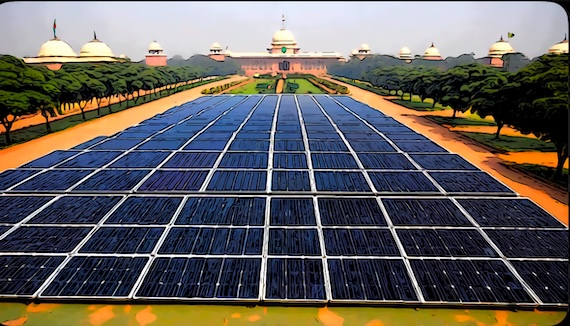Ann Arbor (Informed Comment) – India installed 24.5 new gigawatts of solar power in 2024, along with 3.4 gigawatts of new wind. That represented a doubling of solar installations over 2023. This surge in renewables installations is unprecedented in the country’s history.
In all, India has roughly 100 gigawatts of installed solar capacity. The United States, with an economy 7.5 times as big and vastly more resources, only has 179 gigawatts of solar.
India saw 18.5 gigawatts of new utility-scale solar projects implemented, nearly 3 times as much as in the previous year.
Indians installed 4.59 gigawatts of rooftop solar, impelled by a government program called the Prime Minister’s” Free Electricity Program [Muft Bijli Yojana],” or solar for residences, which was put into effect by Prime Minister Narendra Modi. It successfully promoted 700,000 rooftop solar installations within 10 months of its start. It aims to put rooftop solar on 10 million homes and to spend $8.7 billion.
The big increase in solar installations is thought to be in part because of government incentives and in part because of a steep drop in the price of Chinese solar panels this past year.
India is emerging as one of the more important countries in the world by nominal over-all gross domestic product (GDP). The IMF is projecting its 2025 GDP to be $4,271,922, only a bit less than Japan, which in turn has a somewhat smaller economy than Germany. India is therefore the world’s fifth largest economy, ahead of Britain, France, Italy and Canada. Of course, India’s enormous population is such that its per capital GDP is small. But if we are talking about the place of the country as a whole, it is becoming one of the leading world economies.

“Rashtrapati Bhavan,” Digtial, Dream / Dream v3, Clip2Comic, 2024
India’s transition to green energy is therefore consequential. It is currently the third largest emitter of greenhouse gases after China and the United States. Again, its per capita emissions are small.
Renewables make up 43.6% of the Indian electricity grid, a more impressive number than can be offered by China or the United States. It amounts to 209 gigawatts in total. India hopes to put in 500 gigawatts of renewables by 2030.
Total installed renewable capacity surged nearly 14% in 2024.
India imports half of the natural gas it uses, and spent some $15 billion a year on these imports in 2024. The Financial Express reports that India’s natural gas import costs rose by 18.5% last year, reaching $7.7 billion in the first half of the current fiscal year. That was up from $6.5 billion in the same period last year. This increase is attributed to a higher demand, particularly from city gas distribution companies and the power sector.
India is still poor on a per capita basis and would benefit from not having to spend $14 billion a year on fossil gas imports, especially since it could have the same energy for free from the sun.
Further, being beholden to Trump, the UAE, and Nigeria for imports of Liquefied Natural Gas is a security issue for India, which has such abundant solar that it does not need to put itself in that situation. US sanctions have already forced India to back off imports of Russian fossil gas.


 © 2025 All Rights Reserved
© 2025 All Rights Reserved